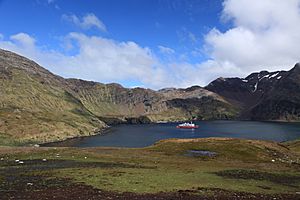Barff Peninsula facts for kids
Barff Peninsula (54°19′S 36°18′W / 54.317°S 36.300°W) is a cool piece of land that sticks out into the sea on South Georgia Island. It's about 8 miles (13 km) long. This peninsula forms the eastern edge of Cumberland East Bay.
Explorers probably first saw Barff Peninsula in 1775 with Captain James Cook. The whole peninsula is named after Barff Point, which is its farthest tip. Barff Point got its name from Royal Navy Lieutenant A.D. Barff. He helped map Cumberland Bay in 1906.
Barff Peninsula: Exploring the Coastline
The coastline of Barff Peninsula is very bumpy. It has many bays and coves that go deep into the land. There are also many points and headlands that stick out into the sea. Many of these places have been mapped and given names.
Northeast Side: From Barff Point to Godthul
Just southwest of Barff Point is Cave Point. This name was first used on a British map in 1929.
North of Barff Point, you'll find the Right Whale Rocks. These rocks are separated from the point by Merton Passage. The passage was named by the Discovery Investigations (DI) team. They surveyed the area between 1926 and 1930.
About 1.5 miles (2.4 km) east of Barff Point is Alert Rock. This is a hidden rock that causes waves to break. It was mapped in 1929 by the DI team. They named it after their small boat, the Alert.
As you go east along the coast, you'll reach Cape Douglas. The DI team mapped this cape between 1926 and 1930. It was probably named after Sir Henry Percy Douglas, who was part of the Discovery Committee.
Cape Douglas ends at Lucas Point. This point marks the west side of a small bay called Rookery Bay. Rookery Point is on the east side of the bay. The bay and its points were first named on a British map in 1930.
Near Rookery Bay are the Skrap Skerries. These are a group of small islands and rocks. Martin Valley crosses the peninsula from Rookery Bay to Cumberland East Bay. It was renamed by the UK Antarctic Place-Names Committee (UK-APC) in 1988. This was to avoid confusion with another valley. It's now named after Stephen J. Martin, a station commander.

East of Rookery Point is Skua Point. This point marks the start of Cobblers Cove. Cobblers Cove is a small cove where boats can anchor. Babe Island is at the entrance to the cove. The Cut separates the island from the cove.
The DI team mapped these in 1929. They first called the cove "Pleasant Cove." Later, it was found that whalers and sealers called it Skomaker Hullet. This was because a Norwegian gunner, who used to be a cobbler, first entered it in thick fog. So, the English name Cobblers Cove was approved.
To the south, Long Point separates Cobblers Cove from Godthul. This point was mapped in 1928 by a Norwegian team. It was remapped in 1929 by the DI team. They named it for Walter Hume Long. O'Connor Peak is inland to the west of Long Point.
South Side: Past Godthul
Godthul means "good hollow" in Norwegian. It's a bay about 1 mile (1.6 km) long. It's located between Long Point to the north and Cape George to the south. This bay used to be a whaling station.
Briggs Point sticks out into Godthul. It separates Godthul from Alsford Bay to the east. The name Briggs Point appeared on a DI map in 1929. It's likely named after A.C. Briggs, who was part of the DI survey team. Alsford Bay is a small bay between Briggs Point and Cape George. It was mapped by DI in 1929 and named after Stoker W.B. Alsford, a survey team member.
Reindeer Valley cuts across the peninsula. It runs from Godthul to Sandebugten in Cumberland East Bay. The UK-APC named it because Norwegian whalers brought reindeer to this part of the island in 1909.
Cape George was found in 1775 by Captain James Cook. He named it after George III of the United Kingdom. South of Cape George is Horseshoe Bay, which is about 0.5 miles (0.8 km) wide. The DI team first mapped this bay.
East of the cape is Nansen Reef, a rocky ridge hidden underwater. It's named after the ship SS Fridtjof Nansen. This ship hit the reef and sank in 1906.
Further south is Johannsen Loch, a cove about 0.7 miles (1.1 km) long. The name first appeared on a DI map. Ocean Harbour, a former whaling station, is about 1 mile (1.6 km) to the south. Just southeast is Penguin Bay, which has a lot of kelp. Its name first appeared on a British map in 1931.
To the south, Tijuca Point forms the northwest side of Hound Bay. This point was probably called Penguin Point by the DI team in 1930. Later, the UK-APC changed the name to Tijuca Point. This was to avoid confusion with other places named after penguins. It was named after the ship Tijuca.


